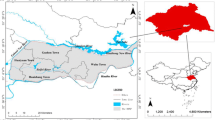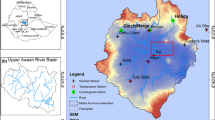Abstract
In this paper, the flood control system of Nanning is taken as the research object. Select calculating the flood control risk rate of reservoir combining with dikes of the urban flood control engineering system as the starting point; According to measured flood sequence, use the SAR(1) model to simulate the flooding; Comprehensively consider the hydrological uncertainty composed of reservoir flood and flood area, the cognitive uncertainty of the flood forecasting error and impact of the uncertainty of the operational management of the cascade reservoir when dispatching delays. The results show that the scientific forecasting and decision-making can reduce the impact of uncertainty factors and improve the flood control capacity of the flood control engineering system of Nanning, and combined dispatching of two reservoirs of Baise and Laokou can meet designed requirements of flood control safety of Nanning when once-in-two centuries flood occurs. With the increase of the flood, the flood risk correspondingly increases, but the risk rate is not large in a certain range. In paper, random combinations of reservoir and interval frequency flood and simulated flood is used to calculate the risk ratio of flood control system to establish a rapid and effective risk calculation method of urban flood control engineering system and the relationship between flood frequency and risk rate, which provides references for flood control system to combine with operation decision of flood control.



Similar content being viewed by others
References
Luo, Q., Zhou, Y., Yang, N., et al.: Risk analysis for flood dispatching based on SAR model and Monte Carlo method. Yangtze River 42(1), 4–8 (2011)
Wanwan, L.V., Shengping, G.U., Lei, H.E., et al.: Calculation and sensitivity analysis of risk probability of earth-rock dam overtopping caused by floods based on Monte-Carlo method. J. Yangtze River Sci. Res. Inst 32(5), 48–52 (2015)
Bao, Z., Liu, J., Zhang, J.: Study on stochastic simulation annual maximum peak discharge of P-III distribution based on the Quasi-Monte Carlo method. J. China Hydrol. 29(6), 33–36 (2009)
Xiao, Y., Guo, S., Xiong, L., et al.: A new random simulation method for constructing synthetic flood hydrographs. J. Sichuan Univ. Eng. Sci. Ed. 39(2), 55–60 (2007)
Zhang, T., Zhao, C., Luo, W.: Random simulation of flood hydrographs based on Copula function. Eng. J. Wuhan Univ. 41(4), 1–4 (2008)
Wang, W., Jin, J., Li, Y., et al.: Hydrological Water Resources Stochastic Simulation Technology. Sichuan University Press, Chengdu (2007)
Zhou, Y., Guo, S., Li, T., et al.: Copula-SAR model and its application for stochastic simulation of regional flood composition. Eng. J. Wuhan Univ. 46(2), 137–142 (2013)
Jiang, S.: Application of stochastic differential equations in risk analysis for flood relief. J. Hydraul. Eng. 3, 1–9 (1994)
Jin, M.: Hydraulic uncertainties and their effects on risk analysis of leeve or spillway systems. J. Hohai Univ. 19(1), 40–45 (1991)
Zhong, P., Zeng, J.: Research on risk analysis of reservoir real-time flood control operation. Water Power 34(2), 8–9 (2008)
Ding, D., Wu, Z., He, S., et al.: Risk analysis on reservoir flood control operation based on selection of flood control level. Water Resour. Hydropower Eng. 36(3), 58–61 (2005)
Yan, B., Guo, S., Guo, J., et al.: Regional design flood composition based on Copula function. J. Hydroelectr. Eng. 29(6), 60–65 (2010)
Mo, C., Dong, Z.: Application of interval analysis to evaluating overtopping risk. Water Power 33(6), 16–18 (2007)
Yeh, W.W.-G.: Reservoir management and operation models: a state-of-the-art review. Water Resour. Res. 12, 1797–1818 (1985)
Simonovic, Slobodan P., Venema, Henry D., et al.: Risk based parameter selection for short-term reservoir operation. J. Hydrol. 131, 269–2911 (1992)
Mo, C., Dong, Z., Ma, R., et al.: Optimal flood dispatch and benefit analysis of Chengbihe reservoir in Guangxi. China Rural Water Hydropower 8, 81–83 (2007)
Salmon, G.M., Hartford, D.N.D.: Risk analysis for dam safety. Int. Water Power Dam Constr 5, 42–47 (1995)
Zhangjun, L.I.U., Shenglian, G.U.O., Yao, H.U., et al.: Flood probability distribution estimation under the influence of upstream reservoir regulation based on Monte Carlo method. J. Hydroelectr. Eng. 41(8), 17–22 (2015)
Wu, Z., Hu, C., Wang, B., et al.: Risk analysis on limited water level of reservoirs in flood season and flood control system in midstream and downstream of Yellow River. J. Hydraul. Eng. 37(6), 641–648 (2006)
Wang, W., Yuan, P., Ding, J.: Wavelet analysis and its application to stochastic simulation of daily flow. J. Hydraul. Eng. 31(11), 43–48 (2000)
Yuan, P., Wang, W., Ding, J.: Nonparametric perturbing nearest neighbor bootstrapping model for simulation of flood time series. J. Sichuan Univ. Eng. Sci. Ed. 32(1), 82–86 (2000)
Ding, J., Deng, Y., Hou, Y., et al.: The study on applicability of “design flood hydrograph” for the design of reservoirs safety withstanding flood. Adv. Water Sci. 3(1), 45–52 (1992)
Wang, X., Zhang, X., Lai, G.: Over-standard integrated risk analysis of flood control system. J. Hydraul. Eng. 2, 83–87 (2004)
Xu, Z.X., Li, J.Y., Ito, K.: Clustering stochastic point process model for flood risk analysis. Stoch. Hydrol. Hydraul. 12(1), 53–64 (1998)
Yen, B.: Risks in hydrologic design of engineering projects. J. Hydraul. Div. ASCE 96(HY4), 959–966 (1970)
Xiao, Y., Guo, S., Xiong, L., et al.: Research review on acceptable risk level for dam safety assessment. J. Saf. Environ. 5(3), 90–94 (2005)
Mei, Y., Tan, G.: Risk criteria for assessment of dam hydrological safety. Int. J. Hydroelectr. Energy 20(4), 8–10 (2002)
Duckstein, L., Bogardi, I.: Application of reliability theory to hydraulic engineering design. Stoch. Hydrol. Hydraul. 12(1), 53–64 (1998)
Tung, Y.K., Mays, L.: Risk analysis for hydraulic design. J. Hydraul. Div. Proc. ASCE 106(HY5), 893 (1980)
Humberto, M.M.: Flood safety analysis. Int. Water Power Dam Constr. 5, 21–24 (1996)
Zhou, H., Dong, S., Deng, C., et al.: Risk analysis on flood control operation of reservoir based on stochastic hydrological process. J. Hydraul. Eng. 37(2), 227–232 (2006)
Funding
Funding was provided by National Natural Science Foundation of China (Grant No. 51369005).
Author information
Authors and Affiliations
Corresponding author
Rights and permissions
About this article
Cite this article
Ma, Ry., Du, Y. & Li, K. Study on flood control risk of flood control engineering system based on the clustering of measured data. Cluster Comput 22 (Suppl 3), 6541–6549 (2019). https://doi.org/10.1007/s10586-018-2315-8
Received:
Revised:
Accepted:
Published:
Issue Date:
DOI: https://doi.org/10.1007/s10586-018-2315-8




